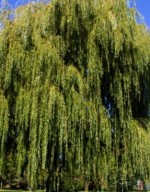 Weeping willow is a deciduous tree native to northern China but widely grown in Europe and the US. It is a member of the willow family, Salicacaea, that also includes poplar, aspen, and cottonwood. The densely branched trees are immediately recognizable by their long, limp, drooping branchlets that sweep to the ground. The furrowed bark is dark-brown to gray-black and the branchlets are green or brown. The simple, alternate leaves are light, shiny green above and gray-green beneath. They are lanceolate with pointed tips, finely toothed, and three to six inches long by ½ to 7/8 inches wide. Non-showy male and female flowers appear in silver green catkins up to 1 inch long on different trees in spring. In early summer female flowers produce one inch long clusters of light brown capsules containing many fine, cottony seeds. Weeping willows are especially beautiful when planted around water but hey have shallow, spreading roots and should not be planted near patios, sewer lines, water pipes,or drains where their invasiveness can cause havoc. In addition, the branches are brittle and break easily in the wind, and trees are generally short-lived.
Weeping willow is a deciduous tree native to northern China but widely grown in Europe and the US. It is a member of the willow family, Salicacaea, that also includes poplar, aspen, and cottonwood. The densely branched trees are immediately recognizable by their long, limp, drooping branchlets that sweep to the ground. The furrowed bark is dark-brown to gray-black and the branchlets are green or brown. The simple, alternate leaves are light, shiny green above and gray-green beneath. They are lanceolate with pointed tips, finely toothed, and three to six inches long by ½ to 7/8 inches wide. Non-showy male and female flowers appear in silver green catkins up to 1 inch long on different trees in spring. In early summer female flowers produce one inch long clusters of light brown capsules containing many fine, cottony seeds. Weeping willows are especially beautiful when planted around water but hey have shallow, spreading roots and should not be planted near patios, sewer lines, water pipes,or drains where their invasiveness can cause havoc. In addition, the branches are brittle and break easily in the wind, and trees are generally short-lived.
Type: Deciduous tree
Outstanding Feature: Habit
Form: Weeping with rounded crown
Growth Rate: Rapid
Bloom: Non-showy male and female flowers in silver green catkins up to 1 inch long on different trees in spring
Size: 30-40’ H x 50-70’ W
Light: Full sun to part shade
Soil: Average, moist, well-drained; tolerates boggy soil.
Hardiness: Zones 6-8
Care: Prune when young in the fall to establish framework; thin out branches annually and avoid cutting off branchlets alone.
Pests and Diseases: Thrips, aphids, scale, borers, caterpillars, lacebugs, blights, powdery mildew, leaf spots, cankers.
Propagation: Hardwood cuttings in winter or early spring